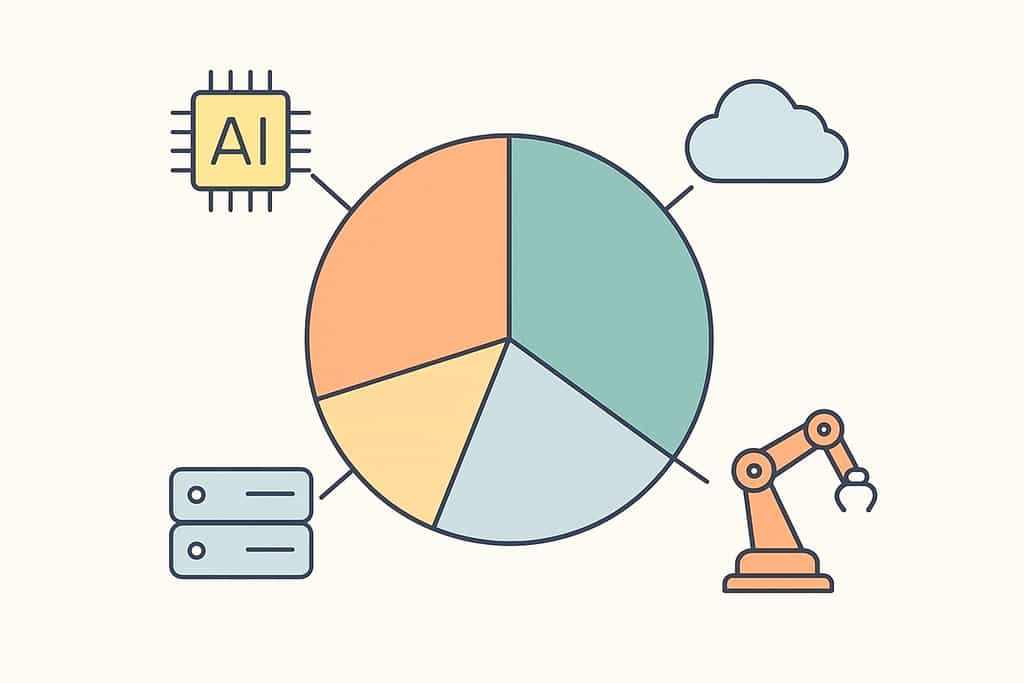AI Investing: From Hype to Practical Strategies That Work
Learn AI investing in plain language. Turn data into signals, automate trades, backtest fast, and connect to your broker without writing code.

Table of contents
- What is AI investing?
- How AI investing works in practice
- Strategies that fit AI-driven investing
- Tools and platforms for AI investing
- Step-by-step: your first AI-powered strategy
- Benefits and considerations
- Measuring success
- Conclusion
- Related articles
- FAQs
What you’ll learn
- How to turn data into signals and executions
- AI-enhanced strategies you can test today
- How to backtest fast and automate with Obside
What is ai investing?
AI investing means using artificial intelligence methods to improve the investment process. In practice, that includes machine learning models that learn from historical data, natural language processing that reads news or filings at scale, and optimization algorithms that help with risk and portfolio allocation. It is different from investing in AI companies. AI investing is about how you invest, not what you invest in.
At a basic level, AI can help you turn raw inputs like prices, volumes, technical indicators, earnings calls, or macroeconomic releases into predictions and decisions. Those decisions can be as simple as an alert when a condition occurs or as advanced as an automated, multi-asset strategy that reacts to real-time events.
If you want a reference on core concepts, see Investopedia’s overview of backtesting and technical indicators.
How AI investing works in practice
To move from theory to profits, three elements must connect: data, signals, and execution.
Data is what you feed your models. It includes prices and volumes, technical features like RSI or MACD, fundamentals such as revenue growth and margins, alternative data like search trends, and unstructured text from news or social posts. The best AI outcomes start with clean, relevant data. If your input is noisy or biased, the smartest model will still fail.
Signals are the predictive patterns you extract. A signal might be a probability that a stock will outperform next week, a sentiment score on a company press release, or a regime classification that says conditions favor trend following over mean reversion. Signals do not need to be perfect. They need to be consistent enough to tilt the odds in your favor when combined with risk controls.
Execution turns signals into positions. This is where latency, risk management, and transaction costs matter. You need rules for position sizing, stop losses, profit targets, and portfolio limits. You also need the ability to act when the world changes, for example when new tariffs are announced or volatility spikes.
A modern AI investing stack should let you experiment fast and deploy reliably. That is why platforms like Obside exist. Obside connects plain-language instructions to real trading actions with your broker or exchange. You describe the idea, validate it with ultra-fast backtests, then switch it on with safeguards. For example, you can say: buy when there is a bullish divergence on RSI on a 15 minutes chart, set a stop loss on the low of the day and a take profit at 10 percent. Obside will execute that logic automatically and manage the lifecycle of the position.
For technical readers who want to dig deeper into algorithms, explore libraries like scikit-learn for classical models and PyTorch for deep learning. For text analysis and event-driven strategies, NLP techniques can turn news into tradable signals.

Strategies that fit AI-driven investing
The best way to understand AI investing is through concrete strategy families and how AI enhances them. You do not need to be a quant to use these ideas, but you should be disciplined about testing and risk.
Trend and momentum with adaptive filters
Traditional momentum looks for assets that are moving strongly and keeps riding the trend. AI can help you adapt the lookback period, filter by volatility, and down-weight false breakouts. In practice, you might combine a Supertrend filter on the 2 hour chart with an 8 hour confirmation and an RSI threshold that avoids overbought entries. That exact logic can be executed automatically on Obside, with a trailing stop set at 5 ATR on the 2 hour chart. For more context on modern trade design, see trading strategies in 2025.
Mean reversion with regime detection
Buying dips works in stable regimes but fails in high-volatility selloffs. A simple classifier that identifies regimes from volatility or correlation patterns can switch your strategy on or off. Even without a heavy model, you can define clear rules: only buy dips when the VIX is below a threshold or when the 20 day realized volatility drops.
Event-driven and news sentiment
AI shines where humans cannot read fast enough. You can use NLP to score headlines, earnings transcripts, or social posts, then trade around significant events. Obside makes this practical with real-time triggers based on news. For example, sell your stocks if new tariffs are announced, or buy oil when a hurricane hits. You can also create alerts like alert me if Apple announces a new product or tell me when OpenAI announces a new AI model.
Factor investing with machine learning
Classic factors like value, quality, and low volatility have long-term edges. Machine learning can blend factors, adjust weights by regime, and handle nonlinear interactions. This is suitable for weekly or monthly rebalancing and avoids overtrading.
Crypto and FX with technical plus order flow context
On faster markets, AI can help filter technical signals with volume spikes or funding rate shifts. A practical instruction could be alert me if Bitcoin rises above 150,000 dollars and daily volume doubles, then buy 1,000 dollars if the price remains above the breakout for 15 minutes. If you trade currencies, learn the basics in our forex trading guide.
Tools and platforms for ai investing
You have two paths: build from scratch or use platforms that hide the plumbing.
Building gives full control. You collect data, feature engineer, train models, handle backtesting, and connect to brokers. The Python ecosystem is the standard choice, with tools like scikit-learn, PyTorch, and pandas. The challenge is maintenance, latency, and integration with execution.
Platforms speed up time to value. Obside is designed to move from idea to execution in seconds. You describe your intent in plain language to Obside Copilot, then the platform turns it into concrete market actions: smart alerts, automatic orders, or portfolio strategies. You can attach conditions to prices, technical indicators, news, or macroeconomic data. Obside also includes an ultra-fast backtesting engine so you can validate logic before going live with your connected brokers and exchanges. It was awarded the Innovation Prize 2024 at the Paris Trading Expo and is supported by Microsoft for Startups.
If you prefer to follow and adapt existing strategies, Obside also offers a marketplace where traders share their logic. You can use them as starting points, then customize risk constraints to fit your goals. To go deeper on system design, read our guide on building, testing, and automating strategies.
When Supertrend turns bullish on the 2h chart and RSI is not overbought, and Supertrend on the 8h chart is bullish, then buy. Add a 5 ATR trailing stop on the 2h chart. Close when the 2h Supertrend flips.

Step-by-step: your first AI-powered strategy this week
You can get practical without writing code. Here is a focused path you can follow in one afternoon.
1) Define a clear objective and horizon
Pick something concrete like improve entries on trending stocks or capture crypto breakouts on the 15 minute chart. Decide whether you want alerts only or fully automated orders.
2) Choose a simple, testable signal
Avoid complex neural networks at the start. Combine two or three conditions that make economic sense. For example, when the Supertrend becomes bullish on the 2 hour chart, if RSI is not overbought and the Supertrend on the 8 hour chart is also bullish, then buy. For selling, reverse the logic. Add a trailing stop-loss at 5 ATR on the 2 hour chart and close the position if the Supertrend on the 2 hour chart changes direction.
3) Backtest quickly and iterate
Use Obside’s backtesting to see the historical performance of your rule set in seconds. Check metrics like max drawdown and Sharpe ratio, then tweak thresholds. If the strategy overfits one market, test across several assets. For a broader starting point, see our practical guide to investing.
4) Decide on automation and risk
Start with small position sizes or paper trading. Set explicit stops and take profits. For example, set a stop loss on the low of the day and a take profit at 10 percent, or use a trailing stop based on ATR so risk adapts to volatility.
5) Deploy with guards
In Obside, you can convert your tested logic into a live strategy connected to your broker. You can also schedule systematic behaviors like buy 50 dollars of Bitcoin every Monday at 10:00 AM or keep 50 percent of the portfolio in Bitcoin, 25 percent in Ethereum and 25 percent in USDC.
6) Add event triggers
Layer in news and macro conditions to react faster. Examples include notify me if RSI crosses 70 on EUR/USD and MACD turns bearish or sell all my positions if the S&P 500 drops by 10 percent. You can even automate social triggers, such as buy 50 dollars worth of Tesla if Elon Musk tweets about it.
7) Monitor and refine
Your first version will not be perfect. Track winners and losers by setup type, adjust risk per trade, and consider a rules-based shutdown if volatility explodes. For context on indicators, see Investopedia on RSI, MACD, and ATR.
Benefits and considerations of AI investing
Speed and consistency. AI helps you scan thousands of instruments and news items in real time. It never skips a setup or gets tired. This is powerful when markets move on headlines because you can translate events into rules that act instantly.
Adaptability across regimes. If you include features like volatility and correlations, your strategy can detect when conditions change and adjust exposure. Simple classifiers can be enough to avoid trading the wrong playbook in the wrong market.
Objective decision making. By committing to a tested rule set, you reduce biased decisions. That does not mean you stop thinking. It means you let your thinking happen at design time, not in the heat of the moment.
Measurable learning loop. Because your rules are explicit, you can measure outcomes, test changes, and iterate. This is the core advantage of AI-driven workflows.
Considerations to manage carefully
- Data quality and coverage. Ensure your price data is clean and your news sources are timely.
- Overfitting. A strategy that looks amazing in backtests but fails live is often too complex or tuned to noise. Use out-of-sample tests and cross validation. See Investopedia on overfitting.
- Transaction costs and slippage. Incorporate realistic assumptions in your backtests.
- Risk and drawdowns. Define maximum loss per trade, per day, and per strategy. The aim is durability.
If you are new to performance metrics, read about the Sharpe ratio and maximum drawdown.
Measuring success in AI investing
You need a scoreboard that drives good behavior. Focus on a handful of metrics that reflect your goals.
Return adjusted for risk. Sharpe or Sortino ratios help you understand if returns justify volatility. A higher number is not always better if it comes from overfitting, so compare across assets and time periods.
Drawdown control. Maximum drawdown tells you how deep the worst peak-to-trough loss went. This metric often defines whether a strategy is investable in real life.
Hit rate and profit factor. Hit rate is the percentage of winning trades. Profit factor is total gross profit divided by total gross loss. Many successful strategies win less than half the time but have larger gains than losses.
Capacity and turnover. If your universe is small or illiquid, your edge may disappear as you size up. Monitor how many trades you do and whether liquidity supports your volume.
Process quality. Measure how often you follow your rules, how quickly you respond to anomalies, and how consistent your data pipeline is. AI investing is a process, not a one-time model.
Conclusion: turn intent into execution
AI investing is not about predicting the future with magic. It is about stacking small, consistent edges across data, signals, and execution. You do not need to code to start. You do need to define clear rules, test them honestly, and automate what you can.
If you are ready to move from reading to doing, try building one strategy today. Describe it in plain language to Obside Copilot, backtest it in seconds, and run it with small size on your connected broker. Layer in alerts tied to prices, technical indicators, and news. Measure results, iterate, and scale only when the edge proves durable.
Obside is available on the web and is recognized by professionals for its ability to move from idea to execution quickly. Explore the platform at beta.obside.com and create an account at beta.obside.com/register.
Prefer to jump in now? You can start setting alerts, testing logic, and automating orders in minutes.
Related articles
- Investment Strategies: build, test, and automate yours
- How to Invest: a practical guide to start and succeed
- Forex Trading Guide: how the currency market works
- Trading in 2025: strategies, tools, and day trading guide
- AI Stocks: how to invest and profit from the AI boom
- Best Stocks to Buy Now: a practical investor guide
FAQs
What is the difference between AI investing and investing in AI stocks?
AI investing is the use of artificial intelligence to make investment decisions across any asset class. Investing in AI stocks means buying companies that build or benefit from AI. You can do both, but they are different choices with different risk profiles. If you are interested in stock selection, learn more about investing in AI stocks.
Do I need to learn Python to start with AI investing?
No. Platforms like Obside let you describe strategies in plain language and translate them into executable logic. If you enjoy coding, Python gives you full flexibility with libraries such as scikit-learn and PyTorch, but it is not mandatory for practical results.
Is AI investing only for day traders?
Not at all. AI helps with intraday trading, swing trading, and long-term portfolio management. You can use it to schedule systematic buys, rebalance factor portfolios, or react to macro events within a diversified allocation.
How much data do I need for an effective AI strategy?
Enough to cover multiple market regimes and avoid overfitting. For daily strategies, many years of data are useful. For intraday signals, several months with different volatility conditions can work. Start simple, validate out of sample, and add complexity only when it improves robustness.
Can AI really beat the market consistently?
Some AI-driven strategies can generate consistent edges, especially when they exploit underfollowed signals, combine diverse inputs, and control risk. There are no guarantees. The key is honest testing, realistic costs, and disciplined execution.
How do I connect AI signals to real trades without building infrastructure?
Use a platform that bridges the gap. With Obside, you can set alerts like alert me if Bitcoin rises above 150,000 dollars and daily volume doubles, trigger automatic orders such as buy 1,000 dollars of Bitcoin if the price is below 100,000 dollars, or manage entire portfolios with rules you define. Backtest, deploy, and monitor in one place.
